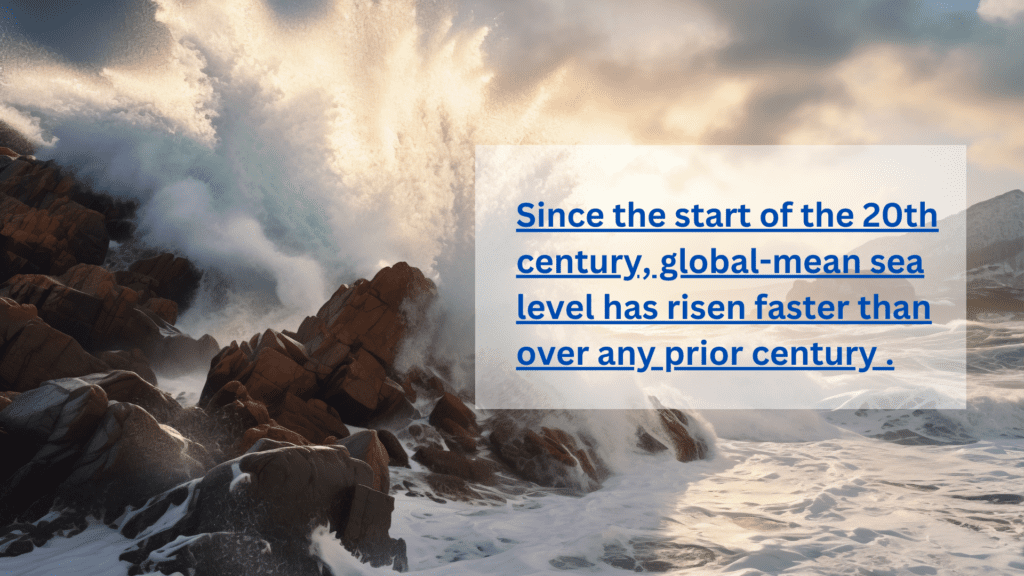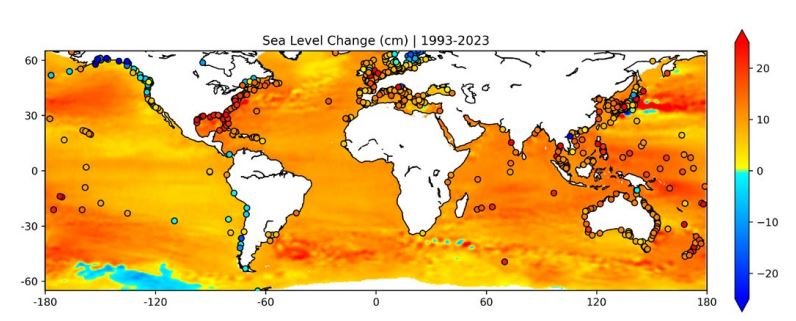Global Sea Levels Rising at Unprecedented Rates Since 1900, Surpassing Any Century in the Last 3,000 Years.
Human-induced global warming is directly causing global sea levels to rise and accelerate, driven primarily by the melting of land ice and the expansion of warming seawater. Their combined effects have led to mean sea-level rising across most of the world’s oceans.

Recent data from NASA shows that in 2023, global-mean sea level rose by 9.4 cm (+/- 1 cm) compared to 1993, marking the highest level in the modern observation record dating back to the 19th century.

Sea Level Rise Doubles in the Last Decade
Since the start of the 20th century, global-mean sea level has risen faster than over any prior century in at least the last 3,000 years, and the rate of increase
is accelerating. According to the World Meteorological Organization (WMO), the rate of SLR in the past ten years has more than doubled since the first decade of the satellite record, increasing from 0.21cm per year between 1993–2002 to 0.48cm per year between 2014–2023.
Melting Polar Ice Drives Accelerated Sea Level Rise
Glaciers and ice sheets, which hold a significant portion of the Earth’s freshwater, are melting as global temperatures rise, particularly in the polar regions. This melting adds vast amounts of water to the oceans, contributing to the recent acceleration in sea level rise. The increasing rates of ice loss from the Greenland and Antarctic ice sheets are the primary drivers, with Greenland losing around 270 billion tonnes of ice per year and Antarctica losing about 150 billion tonnes annually. Notably, the seven worst years of ice loss on record have all occurred within the last decade.

At the same time, the ocean has absorbed more than 90% of the excess heat that has accumulated in the Earth system since 1971 due to rising greenhouse-gas emissions. In 2023, sea-surface temperatures and ocean-heat content reached their highest levels in the observational records.
Between 2006 and 2018, melting land ice contributed to around 45% of the observed change in global-mean sea level, while seawater expansion contributed 39%. Additionally, less than 17% came from human-driven changes in land water storage , such as dam-building or pumping of groundwater into the ocean.
Rising Sea Levels Threaten Coastal Zones and Megacities
Accelerated SLR has the potential to redefine the coastlines of the 21st century. It can pose major risks to the safety, security, and sustainability of many low lying islands, populous coastal megacities, large tropical agricultural deltas, and Arctic communities.
The low-elevation coastal zone (LECZ), extending up to 10 meters above sea level, hosts diverse systems from small islands to major cities and is vital to global GDP and population, with figures projected to surpass 1 billion by 2050. Sea level rise (SLR) poses severe risks, especially for Small Island Developing States (SIDS), causing erosion, infrastructure damage, and economic losses estimated at $1.64 billion annually. Coastal megacities, including New York City and Shanghai, have already seen significant SLR and are expected to face further increases by 2050.









